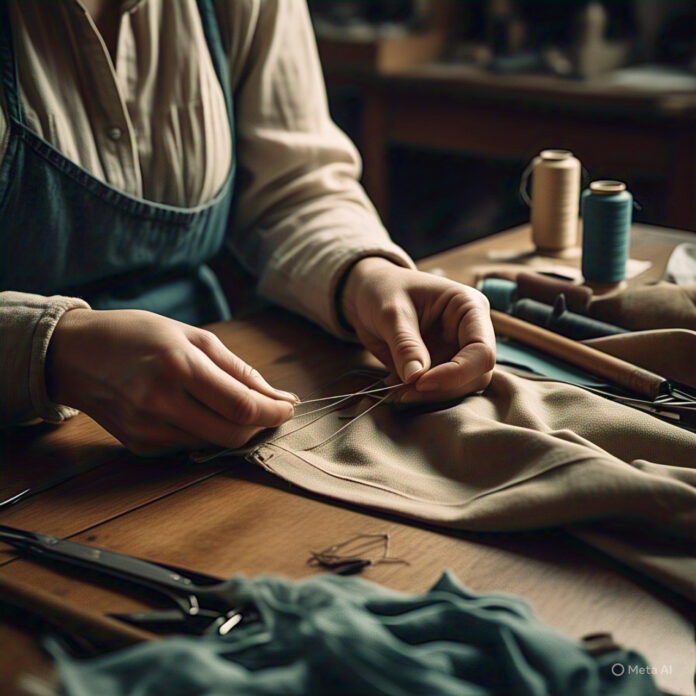Nahttypen – Seams are the backbone of any textile product — from simple shirts to complex couture garments. In the world of sewing and fashion design, Nahttypen (German for “types of seams”) refer to the various ways fabric pieces are joined together to create shape, structure, and design.
Whether you’re a budding tailor, a fashion design student, or simply curious about garment construction, understanding the different Nahttypen is essential. This guide explores the most commonly used types of seams, their applications, and their advantages.
What Are Nahttypen?
Nahttypen are the structural joins between two or more layers of fabric. Each seam type is chosen based on the fabric type, strength required, aesthetics, and purpose of the garment. Some seams are purely functional, while others are decorative or designed to prevent fraying.
Common Types of Nahttypen (Seams)
1. Plain Seam (Geradstich-Naht / Steppnaht)
This is the most basic and widely used seam. It involves placing two fabrics right sides together and stitching along the edge.
- Use: General garment construction
- Pros: Simple, fast, versatile
- Cons: Requires finishing to prevent fraying
2. French Seam (Französische Naht)
A two-step seam that encloses the raw edges within the seam itself, resulting in a clean finish.
- Use: Lightweight and sheer fabrics like chiffon or silk
- Pros: Elegant finish, durable
- Cons: Slightly more time-consuming
3. Flat-Felled Seam (Kappnaht)
A strong seam where one seam allowance is folded over the other and stitched down. Common in denim and workwear.
- Use: Jeans, shirts, heavy-duty garments
- Pros: Extremely durable, no raw edges
- Cons: Slightly bulky, more complex construction
4. Zigzag Seam (Zickzack-Naht)
A seam with a zigzag pattern, often used for stretch fabrics or as a finishing stitch.
- Use: Knitwear, stretchy or elastic materials
- Pros: Allows flexibility, prevents fraying
- Cons: Not suitable for structured garments
5. Double-Stitched Seam (Doppelnaht)
Two rows of stitching for extra strength, often seen in sportswear and children’s clothing.
- Use: Garments requiring strength and durability
- Pros: Strong and secure
- Cons: May add visible bulk
6. Bound Seam (Einfassnaht)
A decorative and clean seam where the edges are enclosed with bias tape or fabric binding.
- Use: High-end garments, unlined jackets
- Pros: Decorative and neat
- Cons: Requires additional materials and time
7. Lapped Seam (Überlappte Naht)
One piece of fabric overlaps the other, and the overlap is stitched down.
- Use: Leather, felt, and non-fraying fabrics
- Pros: Minimal bulk, stylish design element
- Cons: Not ideal for fraying fabrics
8. Overlocked Seam (Overlocknaht / Sicherheitsnaht)
Made using an overlock machine that trims the fabric and encases the edge in thread.
- Use: Mass-produced garments
- Pros: Fast, prevents fraying
- Cons: Requires a serger machine
Factors to Consider When Choosing a Seam Type
Choosing the correct Nahttyp depends on various factors:
- Fabric Type: Lightweight vs. heavyweight, stretch vs. non-stretch
- Garment Use: Formalwear, sportswear, outerwear
- Durability Requirements: Everyday wear vs. occasional use
- Design and Aesthetic: Visible seams vs. hidden seams
- Ease of Construction: Beginner-friendly vs. professional finish
Decorative vs. Functional Seams
Some seams are designed purely for aesthetics, such as topstitching or piped seams, while others prioritize structure and function. In modern fashion, many designers blend the two — using visible seams as stylistic elements while maintaining strength.
Seam Finishing Techniques
Regardless of the Nahttyp, most seams require some form of finishing to prevent fraying and improve longevity:
- Overlocking / Serging
- Pinking Shears
- Bias Binding
- Turned-and-stitched edges
- Taping (for delicate or stretchy fabrics)
Applications in Modern Fashion and Industry
From tailoring to ready-to-wear, seam types are crucial to the garment’s success. For instance:
- Haute couture uses French seams and bound seams for luxury finishes.
- Activewear relies on flatlock and overlocked seams for comfort and durability.
- Denim and workwear use flat-felled seams for maximum strength.
Understanding Nahttypen is not just important for creating clothes but also for evaluating garment quality as a consumer.
Final Thoughts
Seams are much more than simple lines of stitching. They determine how a garment fits, moves, and holds up over time. By understanding the different Nahttypen, you can make smarter design decisions, improve your sewing techniques, and appreciate the craftsmanship behind every piece of clothing.
Whether you’re a fashion designer, tailor, student, or hobbyist — mastering seam types is a vital step on your creative journey.
FAQs About Nahttypen
Q1: What is the strongest seam type?
The flat-felled seam is among the strongest and most durable, often used in denim and outerwear.
Q2: Which seam is best for delicate fabrics?
The French seam is ideal for lightweight, delicate fabrics like silk or chiffon.
Q3: Can I sew all seam types with a regular machine?
Most basic seams can be sewn with a standard machine. Specialized seams like overlocking require a serger.
Q4: What seam is used in T-shirts?
T-shirts commonly use overlocked seams due to their stretch and speed of production.
Q5: Are decorative seams also functional?
Yes, many decorative seams such as topstitching provide both visual interest and structural reinforcement.


